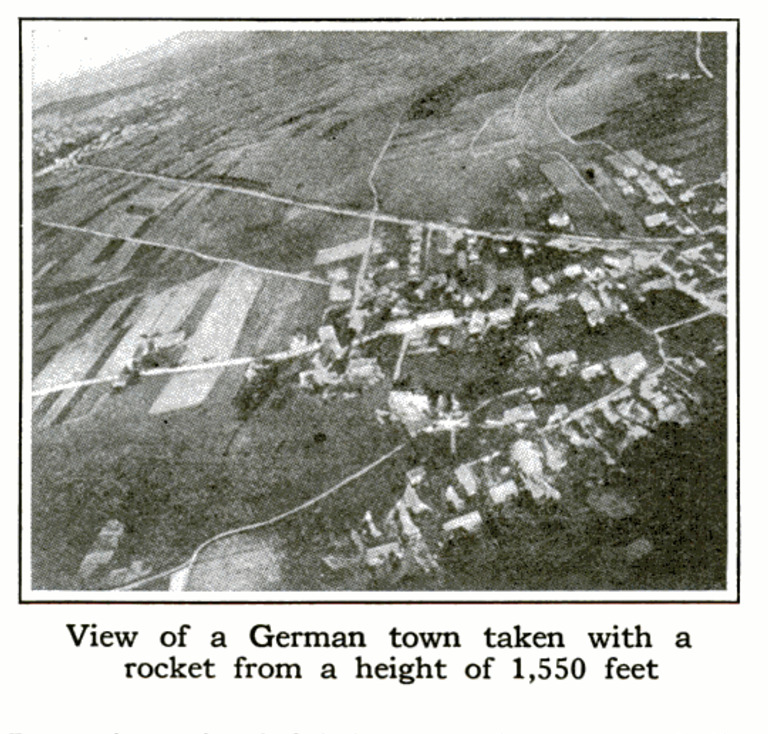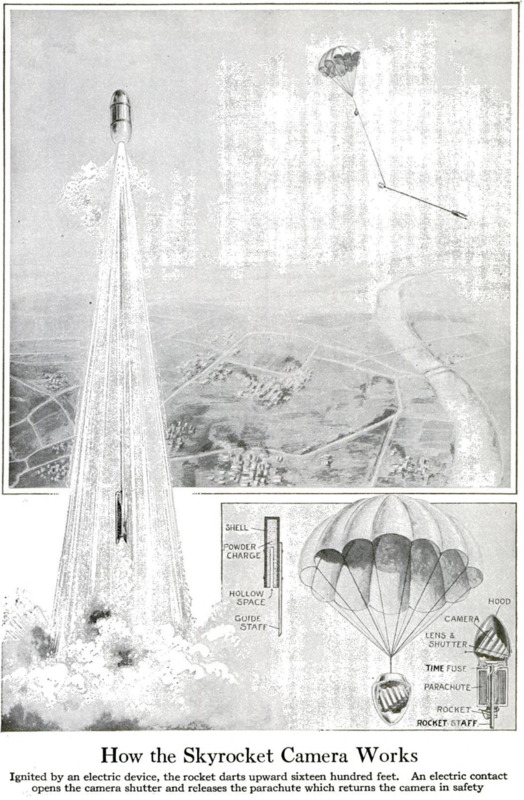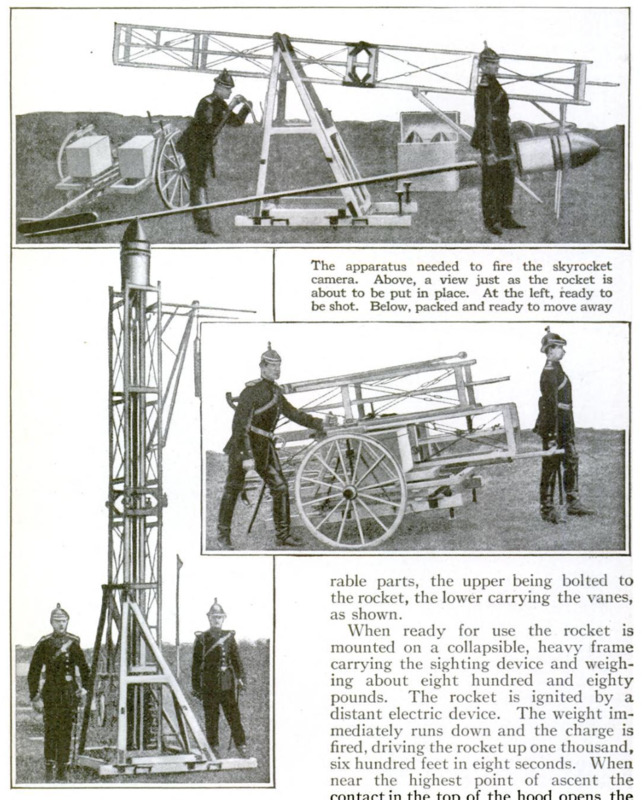Skyrocket camera
Contenuto
-
Titolo
-
Skyrocket camera
-
Article Title and/or Image Caption
-
Taking Photographs From a Skyrocket
-
extracted text
-
AMONG the aids to the conduct of
the war that have been proposed in
Germany is the photography of the
enemy's positions by the flight of rockets
carrying cameras. The invention is less
expensive and can be sent up closer to
the enemy without provoking attack
than a captive balloon, dirigible or aero-
plane. Besides, it is not so dependent
upon the wind as a kite.
When the inventor, Alfred Maul, be-
gan his experiments fifteen years ago,
he found, as he tells us in an article ap-
pearing in Umschau, that the ordinary
rocket can hardly carry a considerable
weight, and so he
was obliged to de-
vise one of greater
strength.
His first inven-
tion was a shell
closed above and
open below con-
taining a firmly
compressed pow-
der composition in
which was a deep
opening. Ignition
developed a con-
siderable volume of
gas, which gas
pressed down upon
the atmospheric
air, thus causing
the rocket to rise. In a shot the initial
velocity is the highest, whereas in the
rocket the initial velocity is low but in-
creases until the charge is burnt out.
This occurs in about one and one-half to
two and one-half seconds, but the rocket
continues to rise, through the force
generated, from six to nine seconds.
In his first camera experiments Mr.
Maul used two small rockets com-
bined. Here the rotary camera, which
could take a picture about one and one-
half inches square and had an oblique
downward inclination, was in a. hood
above the rockets. At the sides of the
rockets were two chambers containing
parachutes of unequal size. The guide-
staff had two vanes at its lower end, like
an arrow, to prevent rotation and change
of direction of the lens. At the highest
point of the flight a time-fuse raised the
shutter and threw out the smaller para-
chute. Just before landing, the larger
parachute was opened. The double
rocket could carry a load of over half a
pound and rose about one thousand feet.
Failures accompanied successes in the
tests. Rockets exploded, parachutes
dropped at the wrong moment and much
costly apparatus was destroyed, before
the inventor saw the cause of his mis-
fortunes, which was that the time taken
for ascent depend-
ed on the density
and moisture of the
air. The exposure
and release of the
parachutes were,
therefore, arranged
independently of
the period of ascent,
by making the up-
per part of the hood
resilient and equip-
ping it with an
electric contact de-
vice. When the
rocket paused for a
momentat its high-
est point of ascent,
the contact opened
the shutter and directly afterward threw
out the first parachute. This proving
successful, the photographic apparatus
was enlarged to a diameter of eight and
one-half inches; the plates were made
four and three-quarters by four and
three-quarters inches, the focal distance
was also four and three-quarters inches.
The length of the equipment was now
over thirteen feet and the weight thirteen
pounds. As the apparatus was still in-
clined to rotate on its axis corrective
experiments were made, but the rocket
proved unable to carry the weight of
a special governing apparatus. Finally,
a gyroscopic device was arranged which
works automatically when the rocket
rises and does not permit rotation.
The present apparatus can rise to a
height of sixteen hundred feet. Its
length is twenty feet, its weight about
fifty-five pounds, and the pictures are
seven and one-quarter inches square. Its
parts are shown on the preceding page.
The guide-staff about fifteen feet long
is made in two united but easily sepa-
rable parts, the upper being bolted to
the rocket, the lower carrying the vanes,
as shown. |
When ready for use the rocket is
mounted on a collapsible, heavy frame |
carrying the sighting device and weigh- |
ing about eight hundred and eighty |
pounds. The rocket is ignited by a |
distant electric device. The weight im-
mediately runs down and the charge is
fired, driving the rocket up one thousand,
six hundred feet in eight seconds. When
near the highest point of ascent the |
contact in the top of the hood opens the
instantaneous shutter and releases the
parachute. As the parachute opens, the
rocket divides into two parts, connected
by a thirty-two-foot belt. The hood and
camera hang just under the parachute,
while the container and staff swing about
thirty-two feet below. The parachute,
relieved of extra weight, lands the camera
without jar in sixty seconds.
-
Autore secondario
-
Alfred Maul (inventor)
-
Lingua
-
eng
-
Data di rilascio
-
1916-05
-
pagine
-
670-672
-
Diritti
-
Public Domain (Google digitized)
-
Archived by
-
Filippo Valle
-
Alberto Bordignon (Supervisor)






